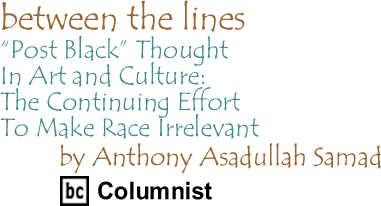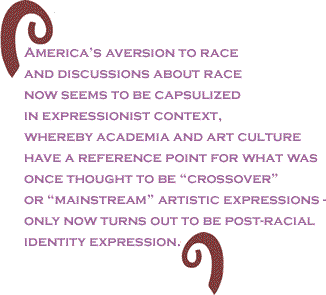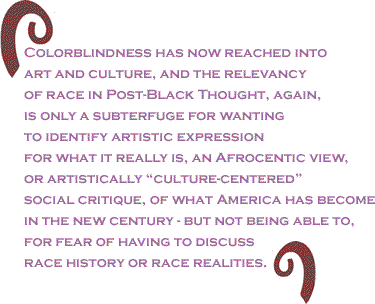
|
|||||||||||||||||||||
|
The current issue is always free to everyone If
you need the access available to a |
 |
 |
The continuing saga to make race irrelevant in America has manifested itself in the realm of art and cultural expression. What was known as “freestyle” expression at the turn of the 21st Century, when 28 African American “post-modernists” had their artwork put display in the late 1990s, to address issues of social cruelty, divided personalities and expressions of non-conformity, was suddenly re-termed “Post-Black” thought throughout the mainstream art world by 2001. The term, “Post-Black,” by an African American art curator, Thelma Golden, during Harlem’s Studio Museum exhibit six years ago, has created a national debate around the move to curb “identity politics” as colorblind politics become more and more entrenched throughout American society. Golden claims she coined the term for these artists who didn’t want their art to be “labeled” by their race. But the label that has been put on them to avoid race labeling has created a larger dilemma about social and cultural identity. America’s aversion to race and discussions about race now seems to be capsulized in expressionist context, whereby academia and art culture have a reference point for what was once thought to be “crossover” or “mainstream” artistic expressions - only now turns out to be post-racial identity expression. It’s also ironic that the effort to racially de-identify these artists as their work has become the buzz of the art world, winning first, or runner-up, for the Johnson Prize (a foundation award set up in 2001 created in honor of William H. Johnson, a black painter who died in 1970, for emerging minority artists) the last five years, and some of the artists have won larger grants in what is really a white dominated post-modernist art culture. Why not call it was it is, a “breakthrough” for black artists and multicultural expression? Or was the fear that white art critics, buyers and art enthusiasts wouldn’t come out and see good art if they thought it was “black art”? So it had to become “Post-Black” art, not only making race relevant but making it real. Like when Sidney Poitier (who the Johnson Foundation recently honored with a life achievement award) first won the Oscar. They didn’t call it “Post-Black” acting. They called it a breakthrough from black actors in mainstream roles. This has been a significant breakthrough for black artists in mainstream post-modernism (the correct term). So much so that the New York Times and the Los Angeles Times has given both the artwork and the term much attention in several articles. It is the New York Times article that has revived the buzz about the legitimacy of the term and its reference as an art “era.” Post-blackness, or post ethnicity, as historian David A. Hollinger stated, have implications that are too far-reaching to ignore—as skin color is one of the defining facts of American life and when you don’t feel compelled to think about skin color, chances are that you are white; and those that do, most likely fit a demographic description, namely, African-American, Asian American, Latino, American Indian, or a blend of any of these. In a 2004 Jewish exhibit in Philadelphia, Cary Leibowitz’s “Assimilatiana: Conscious Consciousness” sought to use mainstream art to establish a Jewish link to the American colonies. When it was suggested that his work was “Post-Jewish” art (in comparison to Golden’s reference to black art), the term was called irreverent as the Jewish community became uncomfortable that artwork suggested that their cultural influence was somehow referred to in post thought. The artwork was re-termed as a link to Minimalism, without the ethnic reference. To suggest that art, like historical periods, have a beginning and an end in cultural context (like the Reconstruction Period, the Civil Rights Period, the Pro-Black Radical Period, Feminist Period and the subsequent, Post-Civil Rights Era) then suggests that there was a “Black Thought” period in the art world that was embraced and appreciated by the mainstream curators. We know that there wasn’t one. So why a Post Black art period? Is there a Post-Feminist, or Post-Gay period to follow? No, many feminist and gay/lesbian artists are mainstream and their experience is an extension of their personal and cultural insights. There is no “post” separation to define them or their desire to mainstream their expression. So it should be for black artists.
The Harlem Book Fair will debate this issue this weekend at the Schomberg’s Langston Hughes Auditorium under the topic, “Post-Black Thinking: Where Black Becomes Irrelevant” (www.qbr.com/page8833.asp), where C-SPAN will give the nation an insight as to how black academics view this new (and convenient) cultural construct. Racism is as prevalent in the “art” and “museum” circles as it is every where else in society where social elites dominate the patronage. Colorblindness has now reached into art
and culture, and the relevancy of race in Post-Black Thought,
again, is only a subterfuge
for wanting to identify artistic expression for what it really
is, an Afrocentic view, or artistically “culture-centered” social
critique, of what America has become in the new century - but
not being able to, for fear of having to discuss race history
or race realities. Or simple fear that race conscious whites
will withhold their appreciation for great breakthrough art if
they knew out of what cultural experience it came. The artist
is supposed to be an extension of the expression. That is what
art’s supposed to be about, isn’t it? Except when
they’re Black. Then the artist becomes secondary to the
expression. Why don’t we call it, Post-Racism Thought?
Because we know, just like there is no “afterthought” on
black expressionism, there has been no afterthought on racial
expressionism. Both are real, and still very relevant. |
| July
19, 2007 Issue 238 |
|
| Printer Friendly Version in resizeable plain text format format |
 |
 |
 |
| |
| |
































